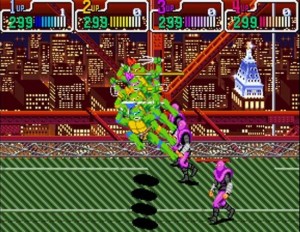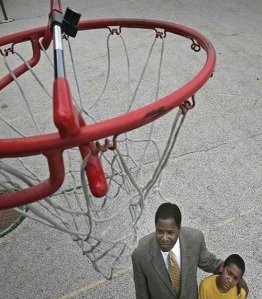We touched on how paper designs are required for the first balance pass, but what exactly is a paper design, and how are they written? A solid paper design streamlines the design process, focuses the team’s effort, and results in a tightly integrated game. A poor one, however, can send the design team into a tailspin as they repeatedly polish something that nobody, not even the rest of the development team, will ever read!
Timing. The first (and possibly most important) key to a good paper design is to write it during Pre-production. At the dawn of the video game industry, Pre-production consisted of a ten minute meeting where the head of the company and the one developer working on a project would get together and decide if the stack of player-controlled pixels were a tank, a spaceship or a wide receiver.

The Cleaveland Browns vs the Miami Space Invaders
Now, with budgets exceeding tens of millions of dollars and schedules spanning several years, the planning stage needs to be a little longer. A disciplined designer will have a firm idea of how the game will play and what the elements will be before asking a team of artists and programmers to start working.
However, the goal of Pre-production is not to come up with a perfect plan ready to be implemented. Game design is an iterative process; progress is made by generating ideas and solutions, prototyping and testing those ideas, and then using the results to generate more ideas. Since there is no way to test a paper design, any iteration will be based on the designer’s imagination, and be very speculative. A disciplined designer will exit Pre-production as soon as they have a firm idea, so the artists and programmers will have enough time to iterate.

Time is money. Wasted time is wasted money.
Audience. The first rule of writing is to know your audience. In the case of this site, I am writing for experienced game designers interested in imporving their craft. In the case of a paper design, the audience is the members of the development team that will be implementing a particular game element.
Every designer generates ideas in different ways, brainstorming, writing stories, creating exhaustive lists or graphs, finding inspiration in other games, and if it works, use it! But most of these methods are not appropriate for communicating those ideas to the rest of the team. The artist responsible for modeling a weapon does not need to know about the 30 bad ideas you rejected. The AI programmer doesn’t have time to read your 30 page backstory about how the enemy monster evolved on a planet with no liquid water. A tool that is useful for generating an idea is rarely useful for communicating it efficiently.
Instead, try to anticipate what an artist or programmer might need to know. What important features will need to be coded? How should the player react to a game element? How is it similar to other elements? How is it different? In what environment or situation is it likely to be encountered? How will it be used in the game?
Length. A paper design should be between 200-300 words, or about half a page of text. A complex game element like an enemy character might stretch to three-quarters of a page, but no longer. Why such an exact limit? Because that is the amount of text that can be read in an average email client without scrolling. Remember, the paper design does not need to exhaustively include every detail; it is intended to communicate the essentials of the design to the people working on it. In order to understand a paper design, they have to actually read it, and most people will not read more than one screen of text. Even if they do read a longer design, they won’t retain it or be able to express it.

Keeping a paper design extremely short will also prevent it from including information that should be recorded somewhere else. For example, if the paper design for a weapon is too long because it explains which button is used for reloading, or how the player can upgrade weapons at the weapon shop, it addressing too many topics that ought to be written elsewhere. A paper design should only include mechanics that are unique to that element, which allows it to be more concise.
Not only that, if your design cannot be expressed succinctly, it will be too complicated for players to understand, as well. If there are too many unique mechanics for an element, players will be overwhelmed by the complexity. A well-written paper design should read like a description in a game manual. A good way to get started is to ask “If I wanted to explain this element to someone as they were playing the game, what would I say?” In short, a paper design should be about as long as this explanation of how long a paper design should be.
Language. A paper design should avoid emotional or vivid language in favor of specificity and clarity. It is easy to conceal fuzzy or flawed ideas beneath beguiling prose. If a paper design is written to be read analytically, it will be held to a higher standard.
Using simple language without rich connotations also helps avoid two common communication problems. First, it leaves programmers less room for interpretation. A paper design that describes a weapon as “powerful” could be implemented in many ways, but one that says “does enough damage to kill a player in one shot” only allows for one. Simple language also allows artists more room for interpretation. A paper design that calls for “a spider with human hands” will probably end up with a pretty silly looking model, but one that describes “a multi-legged creature capable of carrying an infantry weapon” will give the artist more freedom to make something aesthetically interesting.
Now that have a general idea of how to write one, next time we’ll go over what specific information a paper design should contain.







































